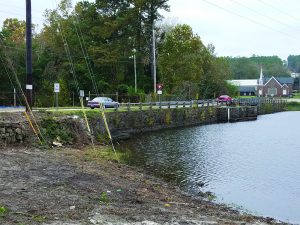Water is extremely important to all life on earth, from small amounts forming deserts to nearly constant storms causing rain forests. Lately the upstate has been moving toward the rain forest habitat. Our waterways are key to carrying away our surpluses, but these creeks and rivers draw us to them in many ways. We love water activities of all kinds, swimming, boating, kayaking, fishing, and on and on. Originally, Native Americans and settlers built homes near the water. Later we know that many of the more lucrative businesses needed close access to water. In the 1800’s before electricity and at the outset of Greenville becoming the Textile Center of the World, waterways provided the energy to move machinery.
Most of us are aware of the grist mills that covered the upstate. A few still visible in Greenville County have large water wheels providing the momentum for work. Many early dams across the area were built with logs. That was the case for the Piedmont Manufacturing Company’s dam at what was then called Garrison Shoals. Piedmont Manufacturing was an early cotton mill being called the “kindergarten” for the mills of the upstate. Under construction in the early 1870s, Mill #1 began producing its’ first sheeting in 1876, and this dam at the Great Shoals of the Saluda served Mills #1 and #2 until 1889 when H.P. Hammett planned Mill #3 across the Saluda in Anderson County. At that point more energy was required for three full size mills, and as the new mill was designed, a new dam was also required. This dam was raised and rebuilt with stone. The engineer purchased working parts from Augusta that are still working and placed a walking bridge atop the new structure so operatives could quickly move across the river from mill to mill. Completed in 1890, this dam has produced energy since. When the mill closed, the dam was sold to an energy company producing electricity to sell to Duke Power.
I’ve known that the dam was old, 128 years in stone. But my question then was, “how does it rank in the state”? So, a search on google led to Graniteville, SC. Still having its mills standing, Graniteville was probably the oldest, extant, cotton mill in the state. Well, first there was an unproductive start in Vaucluse a few miles away. These small towns are near Aiken, SC, and Graniteville Mill was 1845. I began to think Piedmont’s dam was 2nd or 3rd in the state, but I let it mull for a while. Then I decided to try to find more about the Graniteville dam, and as it turned out, it was dams.
I found an article on Newspapers.com that stated the dams in Vaucluse and Graniteville were destroyed by the great Charleston earthquake in 1875. Ok, then, the dam at Vaucluse was rebuilt in 1876, so that’s only 14 years older than Piedmont’s. But it is older. Still not satisfied, I just needed to see these dams. I felt that I didn’t have the complete story. Had all the dams been breached during the quake? Were they still producing energy? I needed to know. So I waited. The way would open. Another clue would present itself.
I joined a Facebook group called Carolina Past. Folks in both North and South Carolina post pictures of wonderful historic structures providing the back story when possible. Soon posts from Graniteville began to appear – my opportunity. Cleve Koon was soon agreeing to give me a tour, and last Monday in the cold rain, I took a field trip to Graniteville and Vaucluse. Preservationist Kyle Campbell and I met Cleve and got the story from the photographer of all things Graniteville. Cleve took us to the graveyard first. There overlooking the Valley is a 40ft. tall aluminum cross and monuments of greats of the area. Next was the Rainbow Falls dam and footbridge, a beautiful but 20th century creation. Vaucluse dam was my must see, because it was the competition, and Cleve lead us to this largest and oldest of the dams there. The flat land, mill pond was several miles long as averse to the mill ponds in the upstate holding back rivers like the Saluda.
Vaucluse was beautiful, but the structure itself was low and not so wide, leading to a spillway maybe 30ft. across. Still standing and older than Piedmont, so at this point, we’re 2nd. Then I asked the other key question, “Is it still producing power?” No. “How long ago did the mill close?” 1991. Ok, then, it may be the oldest. BUT it’s not the oldest still producing POWER! And Piedmont has been a continuously working dam for 128 years! Vaucluse was working from 1876 to 1991, 115 years! And Piedmont dam’s footbridge is 128 years old too! Vaucluse has none. They can drive over it on a one lane paved road, but ……
I’m thrilled. I can say that Piedmont’s dam is the oldest continuously working dam in the state! And no older footbridge over a dam exists in the state. Maybe not in the southeast? Or the nation? Oh, oh. Another search ??????? It’s not over. I thought I could put this one to bed. Never! Questions breed questions.



